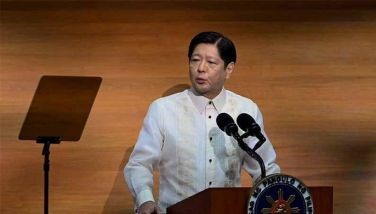Late

President Marcos sought out Rogelio Singson to help government draw up a contingency plan to mitigate the effects of El Niño on our fresh water supply. Singson is former president of Maynilad and is currently CEO of Metro Pacific Water. He served as public works secretary during the administration of Benigno Aquino III.
There is no debate about Singson’s credentials. But the development of an “over-all plan for the Philippines” is coming rather late in the day. We should have developed such a plan years ago when the debilitating effects of climate change were still on the horizon.
Last checked, water supply at the Angat Dam that supplies about 98 percent of the Capital Region’s needs had fallen below the 180 meter “minimum operating level.” This means basically that our one and only dam is dry.
Ipo Dam, through which water passes from Angat going to the La Mesa reservoir, saw its water level drop to 98.59 meters. That is significantly below its operating level.
Maynilad, catering to a customer base of 9.5 million in the densely populated western half of the NCR, announced 9- to 11-hour daily water interruptions. The city is dry. It will become even drier. The El Niño weather episode will peak early next year.
The spokesman for the MWSS said the situation could be mitigated by rains. Of course. But there are no rains forthcoming even as, for once, we are praying for storms to hit us as they should this time of the year.
The situation must be dismal if the agency responsible for ensuring water security is reduced to hoping for rains. That is an event beyond our control.
The Dumagat tribesmen in the Sierra Madre have begun performing ritual dances for rains to come. The MWSS should join them.
Many years ago, when El Niño threatened our water supply, Congress responded by distributing additional pork barrel funds for “mitigation measures.” The money was spent digging wells all over the city to pump out ground water. But even the ground water had dried up. Overexploitation of ground water caused subsidence in several low lying communities.
Zooming out, a recent global study showed that overexploitation of aquifers caused the Earth to shift at its axis. It takes thousands of years for aquifers to fill up. Pumping water out of them will never be a sustainable solution.
Besides, if water levels at the aquifers drop, they worsen conditions above ground. They dry up our mountains and agricultural areas.
All the deep wells drilled using Congress’ pork barrel funds for “mitigation measures” are now dry and useless. So much money was wasted on an unscientific solution to the water crisis.
We can only hope whatever contingency plan is devised during this moment of water emergency will not repeat the same folly. The only real solutions to the water crisis will take years to plan, finance and build. There are no shortcuts.
We should have begun acting on this crisis years ago.
Rollouts
We have at least begun to streamline the permitting process for other areas of our infrastructure. Executive Order 32, recently signed by President Marcos, simplifies the permitting process for the construction, installation, repair, operation and maintenance of our telecommunications and internet infrastructure.
Executive Order 32 benefitted from inputs from telco workshops organized by the Anti-Red Tape Authority (ARTA). The second of these workshops was sponsored by PLDT and Smart. It was participated in by a number of government agencies and non-government organizations such as: the DPWH, the NEA, the new Department of Human Settlements and Urban Development (DHSUD), the Philippine Association of Building Officials, the DILG and the DICT.
The workshop series is part of ARTA’s “Bayanihan” initiative that aims to bring together all stakeholders to help clear the bottlenecks in the permitting process that produced so much delay in building our infrastructure – our telecommunications, particularly. In many instances, an unnecessary number of signatures are required to build a simple telecoms tower, causing the process to stretch for years. This is something that needs to be corrected if we aspire to keep up with the more nimble economies in the region.
PLDT and Smart CEO Alfredo Panlilio was especially pleased by the issuance of Executive Order 32. This will help our telcos speed up the rollout of their fixed and wireless networks. He committed his company’s support to the continuation of the ARTA workshops.
“Through collaborations such as this workshop,” Panlilio said, “we hope to address the urgent need to operationalize policies to ultimately ensure the highest possible quality of service for all Filipinos and, consequently, support the government’s digitalization effort.”
State of art telecommunications is critical to achieving competitiveness for the country. It is bad enough that we are suffering from a “learning deficit” while competing against a country like Vietnam, which has among the best educational systems in the world. It will be worse if our telecommunications lag behind due to an abundance of red tape.
ARTA is on the right track organizing consultations among stakeholders instead of merely producing ivory tower studies about efficient governance. There is much about the way we do things that slows down our modernization.
ARTA deputy director general for Operations Gerald Divinagracia said this well in his remarks to workshop participants. “The President,” he said, “has set forth a bold and transformative vision for our nation: the digitalization of our economy.”
That digitalization will not happen if investors are held up by the usual red tape.
- Latest
- Trending



























